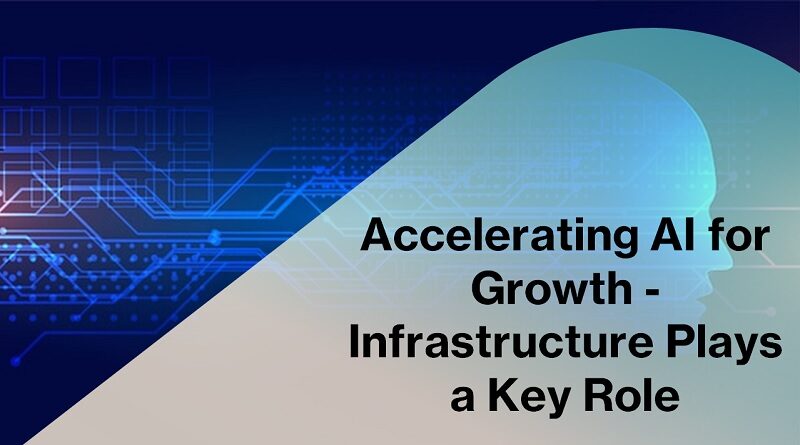Accelerating AI for Growth – Infrastructure Plays a Key Role
Businesses all over the world have realised how important artificial intelligence (AI) is to driving change and company expansion. Many CIOs will start asking “how?” about AI in 2023 rather than “why?” What is the most efficient strategy to scale up AI production rapidly and affordably while still generating value and corporate growth?
CIOs must facilitate the quick, widespread development, deployment, and maintenance of valuable AI workloads. It’s a delicate balancing act. Enterprise IT directors must also better target their spending, including expensive “shadow AI,” in order to get the most out of their strategic technology investments. This can then help finance continued, profitable AI innovation, starting a positive feedback loop.
High-performance AI infrastructure, such as purpose-built platforms and clouds with optimised processors, accelerators, networks, storage, and software, provides CIOs and their organisations with a strong means of juggling these ostensibly conflicting demands, allowing them to efficiently manage and speed up the orderly growth and “industrialization” of production AI.
Standardizing on a “AI-first” platform that is public cloud-based and expedited offers on-demand services that may be utilised to swiftly design and deploy powerful, high-performing AI applications. Enterprises may manage associated costs, lower the barrier to AI, reuse priceless intellectual property, and, most importantly, keep valuable internal resources concentrated on data science and AI rather than infrastructure with the aid of an end-to-end ecosystem.
Three key conditions for driving the evolution of AI
Focusing on AI infrastructure as a key enabler of AI and business growth has the advantage of assisting businesses in effectively completing three key requirements. In our own groundbreaking work in the field and, more widely, in the growth and adoption of technology over the past 20 years, we and others have noticed these. Standardization, cost control, and governance are them.
Standardization of AI
AI is a revolutionary game-changer with even larger potential influence both inside and beyond the company, much like big data, cloud, mobile, and PCs before it. Smart businesses will wish to standardize on accelerated AI platforms and cloud infrastructure, similar to these prior advancements like virtualization, big data and databases, SaaS, and many more, after thorough review. This results in a number of well-known advantages for this most recent collection of universal tools. For instance, large banks owe a large portion of their lauded capacity for rapid growth and expansion to standardized, international platforms that allow for swift development and deployment.
Standardizing on efficient stacks, pre-integrated platforms, and cloud environments with AI helps businesses avoid the myriad drawbacks that frequently come with offering a disorganised array of goods and services. The following are the most significant ones: poorly managed procurement, poor model performance, duplicated efforts, inefficient workflows, difficult replication or scaling of pilots, more expensive and sophisticated support, and a lack of specialised employees. The extra time and cost involved in choosing, constructing, integrating, tuning, deploying, and maintaining a complex stack of hardware, software, platforms, and infrastructures is perhaps the most serious.
It should be made clear that corporate standardisation of AI platforms and clouds does not imply one-size-fits-all solutions, vendor exclusivity, or a return to strictly centralised IT governance.
Contrarily, contemporary AI cloud infrastructures ought to provide tiers of services that are tailored for a variety of use cases. The “standardised” AI platform and infrastructure should be created with specific scalability, performance, software, networking, and other capabilities for various AI workloads. A cloud marketplace that is well-known to many business users offers AI developers a number of vetted options.
Regarding portability, Kubernetes, containerization, and other open, cloud-native methods allow for simple mobility between providers and multiclouds, allaying worries about lock-ins. Additionally, corporate standards can overlay on current procurement policies and procedures, including decentralized approaches, while also restoring a CIO’s overall visibility and authority.
Cost management for AI
According to various estimates, unlawful spending, frequently by business organizations, increases technology budgets by 30% to 50%. Even while precise numbers for this “shadow AI” are difficult to find, polls of company IT objectives for 2023 indicate that it is likely that concealed expenditures in goods and services will account for a sizeable portion of AI infrastructure costs. The good news is that centralized enterprise-standard AI services procurement and provisioning restore institutional control and discipline while giving organizational users flexibility.
Like any other job, the cost of AI depends on the amount of infrastructure that must be purchased or rented. CIOs aim to assist organisations working on AI avoid both over- and under-provisioning (which can be costly and result in underutilised on-premises infrastructure) (which can slow model development and deployment, and lead to unplanned capital purchases or overages of cloud services).
It’s wise to consider AI costs in a new way in order to prevent these extremes. By adopting a strong, optimised platform, accelerated processing for inference or training may (or may not) initially cost more. However, if the work is completed more quickly, less infrastructure will need to be rented for a shorter period of time, lowering the cost. And maybe most significantly, the model can be implemented sooner, giving the user a competitive advantage
This expedited time-to-value is comparable to the difference between taking the 15-hour drive from Chicago to Dallas and taking a nonstop flight (5 hours). The other will get you there much more quickly, although one may cost less (or given current gas costs, more). Which is “valuable” more?
In AI, examining development costs from a total cost of ownership perspective might prevent the usual error of focusing solely on raw costs. As this study demonstrates, it is a wiser choice for our road journey to arrive more quickly, with less wear and tear and less chances for detours, accidents, traffic jams, or missed turns. The same is true for quick, efficient AI processing.
A company’s data science teams can work more productively and the trained network can be deployed more quickly with shorter training timeframes. Another significant advantage is that the costs are cheaper. Customers frequently see a cost reduction of 40% to 60% compared to a non-accelerated strategy.
On how many GPUs can you train a sophisticated large-language model (LLM)? On a few GPUs, optimising an existing model? executing global real-time inferencing for inventory As we mentioned above, knowing and budgeting for AI workloads in advance ensures that provisioning is well-matched to the task and the budget.
Governance of AI
Recently, the term “AI governance” has taken on a variety of connotations, ranging from ethics to explainability. In this context, it alludes to the capability of evaluating cost, value, auditability, and compliance with legal requirements, particularly in relation to data and consumer information. The capacity of businesses to quickly and openly ensure continuous accountability will continue to be more important than ever as AI develops.
Again, an automated AI cloud infrastructure may offer measurements and support for this essential demand. Additionally, a number of security features integrated into different layers of purpose-built infrastructure services — including GPUs, networks, databases, developer kits, and more, soon to include confidential computing — contribute to defence in depth and essential secrecy for AI models and sensitive data.
An additional note on roles and obligations: It cannot be the CIO’s only responsibility to swiftly achieve maximum value and TCO leveraging modern, AI-first technology. It necessitates close coordination with the chief data officer (or equivalent), data science leader, and, in certain businesses, chief architect, as with other AI programmes.
Finally, pay attention to how And Now
Today, most CIOs are aware of the “why” of AI. It’s time to prioritise “how” strategically. Businesses who are adept at expediting simple AI development and implementation will be far better equipped to optimise the return on their AI investments. This can entail accelerating new application development and innovation, making it simpler and more widespread for businesses to embrace AI, or just hastening time-to-production-value. If they don’t, technology leaders run the risk of producing AI that grows erratically in pricey patches, limiting acceptance and progress and giving their rivals an advantage who are more agile and well-managed.




